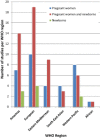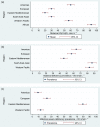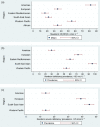Global summary of maternal and newborn vitamin D status - a systematic review
- PMID: 26373311
- PMCID: PMC6860156
- DOI: 10.1111/mcn.12210
Global summary of maternal and newborn vitamin D status - a systematic review
Abstract
Pregnant women and newborns are at increased risk of vitamin D deficiency. Our objective was to create a global summary of maternal and newborn vitamin D status. We completed a systematic review (1959-2014) and meta-analysis of studies reporting serum 25-hydroxyvitamin D [25(OH)D] concentration in maternal and newborn populations. The 95 identified studies were unevenly distributed by World Health Organization (WHO) region: Americas (24), European (33), Eastern Mediterranean (13), South-East Asian (7), Western Pacific (16) and African (2). Average maternal 25(OH)D concentrations (nmol L(-1) ) by region were 47-65 (Americas), 15-72 (European), 13-60 (Eastern Mediterranean), 20-52 (South-East Asian), 42-72 (Western Pacific) and 92 (African). Average newborn 25(OH)D concentrations (nmol L(-1) ) were 35-77 (Americas), 20-50 (European), 5-50 (Eastern Mediterranean), 20-22 (South-East Asian), 32-67 (Western Pacific) and 27-35 (African). The prevalences of 25(OH)D <50 and <25 nmol L(-1) by WHO region in pregnant women were: Americas (64%, 9%), European (57%, 23%), Eastern Mediterranean (46%, 79%), South-East Asian (87%, not available) and Western Pacific (83%, 13%). Among newborns these values were: Americas (30%, 14%), European (73%, 39%), Eastern Mediterranean (60%, not available), South-East Asian (96%, 45%) and Western Pacific (54%, 14%). By global region, average 25(OH)D concentration varies threefold in pregnant women and newborns, and prevalence of 25(OH)D <25 nmol L(-1) varies eightfold in pregnant women and threefold in newborns. Maternal and newborn 25(OH)D concentrations are highly correlated. Addressing vitamin D deficiency in pregnant women and newborns should be a global priority. To protect children from the adverse effects of vitamin D deficiency requires appropriate interventions during both pregnancy and childhood.
Keywords: 25-hydroxyvitamin D; newborn; pregnancy; prevalence; vitamin D; vitamin D deficiency.
© 2015 John Wiley & Sons Ltd.
Conflict of interest statement
The authors declare that they have no conflicts of interest.
Figures




Similar articles
-
Effectiveness and safety of vitamin D in relation to bone health.Evid Rep Technol Assess (Full Rep). 2007 Aug;(158):1-235. Evid Rep Technol Assess (Full Rep). 2007. PMID: 18088161 Free PMC article.
-
[Relationship between 25(OH)D levels during pregnancy and maternal blood glucose, lipids with maternal and neonatal immunity indicators].Wei Sheng Yan Jiu. 2025 May;54(3):405-418. doi: 10.19813/j.cnki.weishengyanjiu.2025.03.008. Wei Sheng Yan Jiu. 2025. PMID: 40550605 Chinese.
-
Vitamin D supplementation for women during pregnancy.Cochrane Database Syst Rev. 2016 Jan 14;(1):CD008873. doi: 10.1002/14651858.CD008873.pub3. Cochrane Database Syst Rev. 2016. Update in: Cochrane Database Syst Rev. 2019 Jul 26;7:CD008873. doi: 10.1002/14651858.CD008873.pub4. PMID: 26765344 Updated.
-
Associations of Maternal Vitamin D Deficiency with Pregnancy and Neonatal Complications in Developing Countries: A Systematic Review.Nutrients. 2018 May 18;10(5):640. doi: 10.3390/nu10050640. Nutrients. 2018. PMID: 29783717 Free PMC article.
-
Vitamin D replacement in children, adolescents and pregnant women in the Middle East and North Africa: A systematic review and meta-analysis of randomized controlled trials.Metabolism. 2017 May;70:160-176. doi: 10.1016/j.metabol.2017.02.009. Epub 2017 Feb 16. Metabolism. 2017. PMID: 28403940 Free PMC article.
Cited by
-
Mediation Effect of Social Distancing on Neonatal Vitamin D Status and Related Clinical Outcomes during the Coronavirus Disease-19 Pandemic.Nutrients. 2024 Jun 13;16(12):1858. doi: 10.3390/nu16121858. Nutrients. 2024. PMID: 38931213 Free PMC article.
-
High-Dose Vitamin D Supplementation Significantly Affects the Placental Transcriptome.Nutrients. 2023 Dec 7;15(24):5032. doi: 10.3390/nu15245032. Nutrients. 2023. PMID: 38140291 Free PMC article.
-
Development of a predictive scoring system for vitamin D deficiency 'Vitamin D Deficiency Predicting Scoring (ViDDPreS)' based on the vitamin D status in young Japanese women: a nationwide cross-sectional study.Public Health Nutr. 2024 Sep 27;27(1):e185. doi: 10.1017/S1368980024001708. Public Health Nutr. 2024. PMID: 39327919 Free PMC article.
-
The prevalence and determinants of vitamin D deficiency in Indonesian infants at birth and six months of age.PLoS One. 2020 Oct 5;15(10):e0239603. doi: 10.1371/journal.pone.0239603. eCollection 2020. PLoS One. 2020. PMID: 33017838 Free PMC article.
-
Predictors of 25-hydroxyvitamin D concentrations during pregnancy: A longitudinal analysis in the Brazilian Amazon.Eur J Clin Nutr. 2022 Sep;76(9):1281-1288. doi: 10.1038/s41430-022-01102-9. Epub 2022 Feb 21. Eur J Clin Nutr. 2022. PMID: 35190660
References
-
- Aghajafari F., Nagulesapillai T., Ronksley P., Tough S., O'Beirne M. & Rabi D. (2013) Association between maternal serum 25‐hydroxyvitamin D level and pregnancy and neonatal outcomes: systematic review and meta‐analysis of observational studies. British Medical Journal 346, 1–14. - PubMed
-
- Ainy E., Ghazi A. & Azizi F. (2006) Changes in calcium, 25(OH)D3 and other biochemical factors during pregnancy. Journal of Endocrinological Investigation 29, 303–307. - PubMed
-
- Ala‐Houhala M., Koskinen T., Parviainen M. & Visakorpi J. (1988) 25‐Hydroxyvitamin D and vitamin D in human milk: effects of supplementation and season. American Journal of Clinical Nutrition 48, 1057–1060. - PubMed
-
- Amukele T.K., Soko D., Katundu P., Kamanga M., Sun J., Kumwenda N.I. et al (2013) Vitamin D levels in Malawian infants from birth to 24 months. Archives of Disease in Childhood 98, 180–183. - PubMed
-
- Andiran N., Yordam N. & Ozon A. (2002) Risk factors for vitamin D deficiency in breast‐fed newborns and their mothers. Nutrition (Burbank, Los Angeles County, Calif.) 18, 47–50. - PubMed
Publication types
MeSH terms
Substances
LinkOut - more resources
Full Text Sources
Other Literature Sources
Medical

